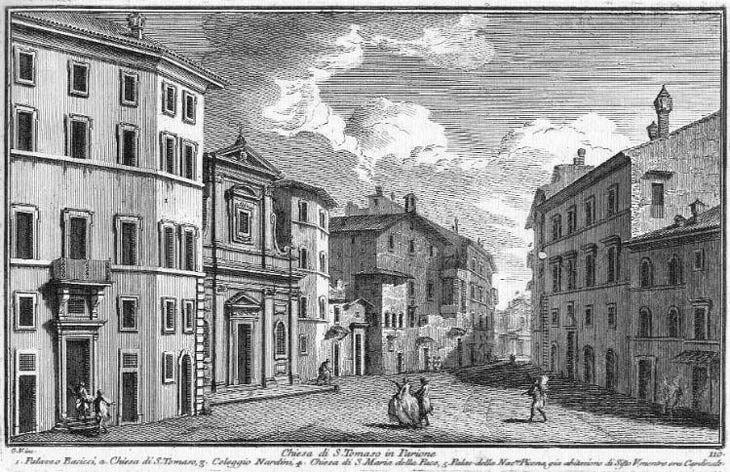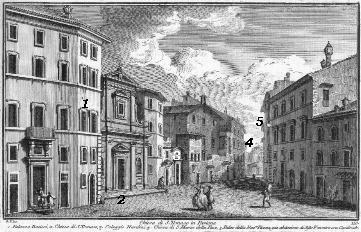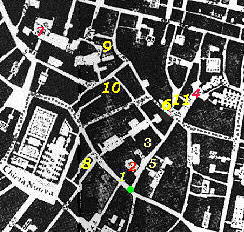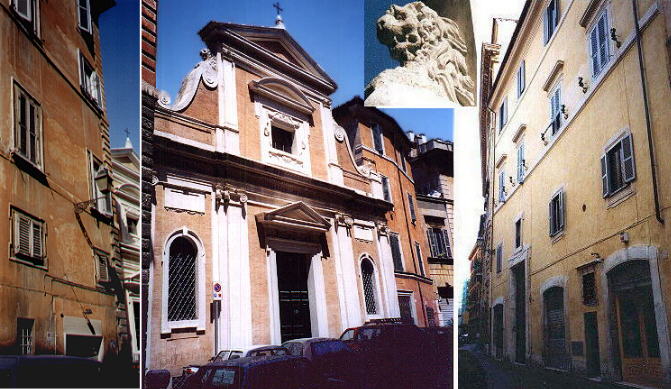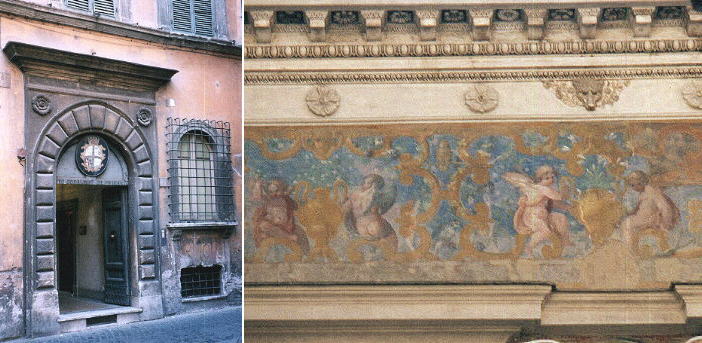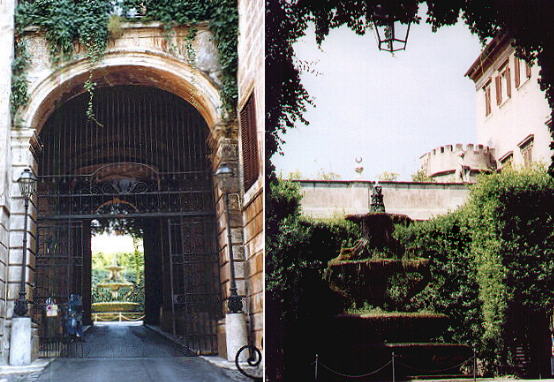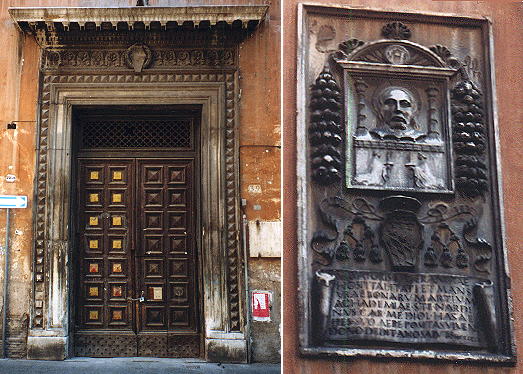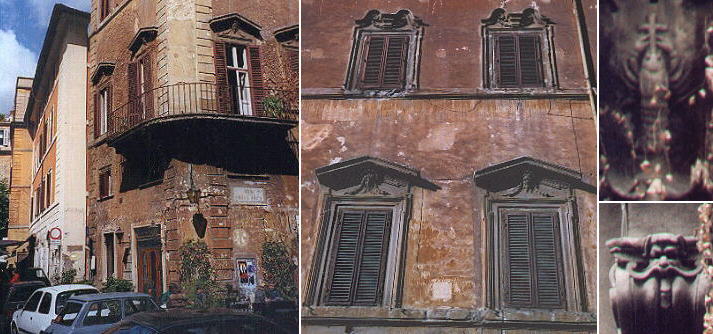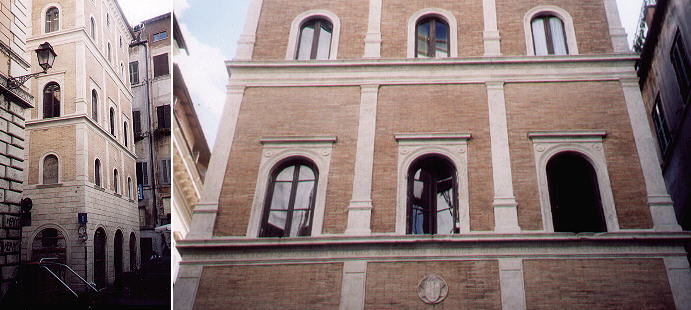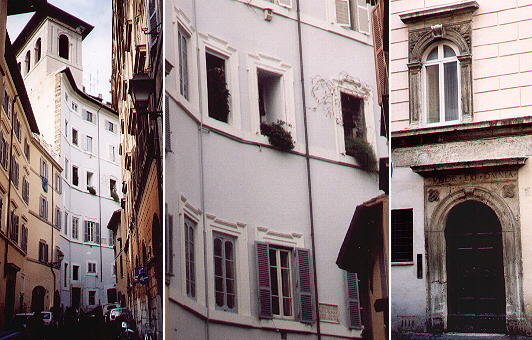  S. Tommaso in Parione (Book 6) (Day 4) (View C6) (Rione Ponte) and (Rione Parione) In this page: The plate by Giuseppe Vasi Today's view Palazzo della Nazione Picena Palazzo sul Monte Giordano Palazzo Nardini o del Governo Vecchio S. Biagio della Fossa e Palazzo Gambirasi Palazzetto Turci Palazzo Tanari e Casa di Teodoro Amayden The Plate (No. 110)
The small church of S. Tommaso in Parione (Parione being the name
of the area) is the excuse for showing the perspective leading to S. Maria
della Pace. Alexander VII asked Pietro da Cortona to redesign the façade
of this church and the access to it and Pietro da Cortona, to facilitate
the passage of the carriages, enlarged Via del Parione by cutting the edge
of Palazzo della Nazione Picena. The view is taken from the green dot in the small 1748 map here below.
In the description below the plate Vasi made reference to: 1) Palazzo Bacicci;
2) S. Tommaso; 3) Collegio Nardini; 4) S. Maria della Pace; 5) Palazzo della Nazione Picena.
4) is shown in detail in another page. The small map shows also 6) S. Biagio della Fossa; 7) Palazzo di Monte Giordano; 8) Palazzetto Turci; 9) Palazzo Tanari; 10) Casa di Teodoro Amayden; 11) Palazzo Gambirasi.
The dotted line in the small map delineates
the border between Rione Ponte (upper part) and Rione Parione (lower part).
The interior of the church was largely altered in the XIXth century, but the simple XVIth century façade by Francesco da Volterra was not touched. The lions are linked to Sixtus V who lived nearby when he was a Cardinal. Palazzo Bacicci has lost its XVIIIth century looks.
Nazione Picena is a reference to the current Italian region called Le Marche which includes Urbino, Ancona, Macerata and Ascoli Piceno, so the coat of arms is split into quarters. Sixtus V was born near Ascoli Piceno and lived many years in this palace, the interior of which has very interesting frescoes.
Monte Giordano is a small elevation between Via del Parione and the river. Here in the XIVth century Giordano Orsini built a fortress commanding the papal road. This elevation is quoted in Dante's Divina Commedia (Inferno XVIII 30-33). The bear of the Orsini is still visible in the courtyard of the XVIIIth century palace which replaced the fortress. The fountain is a baroque work by Antonio Casoni (and the bear was part of it). Palazzo Nardini o del Governo Vecchio
The plate makes a reference to Collegio Nardini. The institution was moved there when the large palace built by Cardinal Stefano Nardini in XVth century in the nearby Via del Governo Vecchio became the residence of the Governor of Rome. Later on the Governor moved to Palazzo Madama, so the street was called Via del Governo Vecchio (Street of the Old Government). S. Biagio della Fossa e Palazzo Gambirasi
The little church of S. Biagio della Fossa was pulled down in 1812 by the French. It was located on the site now occupied
by the orange building on the far left. Via della Pace (peace) is
actually very peaceful during the day, but at night is pretty busy.
The building on the corner is a fine example of XVIIth century window design by Giovanni Antonio de' Rossi.
It belonged to Donato Gambirasi, whose name evokes the word gambero (shrimp): this explains the shrimp holding a cross which appears in the main portal.
Palazzetto Turci in Via del Governo Vecchio is a fine Renaissance house, which was for some time attributed to Donato Bramante. Palazzo Tanari e Casa di Teodoro Amayden
The narrow streets between S. Maria della Pace and Palazzo di Monte Giordano are known
only to those who live there. They retain several buildings of the XVIth and XVIIth centuries. Palazzo Tanari, behind
Palazzo di Monte Giordano, has a loggia with a very fine view. A Renaissance house was thought to
have belonged to Teodoro Amayden, a Flemish lawyer who settled in Rome towards the end of the XVIth century: he is known for a
treaty on the Roman noble families.
Next plate in Book 6: S. Caterina della Ruota Next step in Day 4 itinerary: S. Maria della Pace Next step in your tour of Rione Ponte: S. Simeone Profeta Next step in your tour of Rione Parione: S. Nicola dei Lorenesi
Go
to |
All images © 1999 - 2003 by Roberto Piperno. Write to romapip@quipo.it
